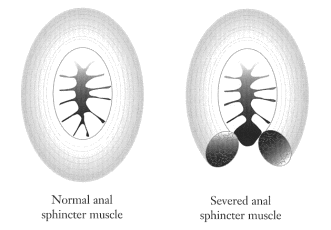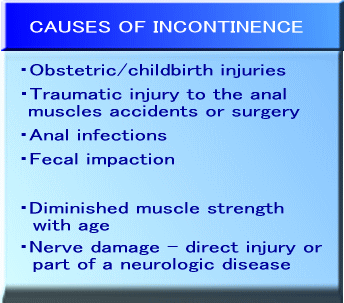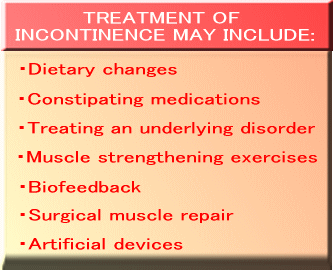|
||||||||||
|
|
||
| Ā° WHAT IS INCONTINENCE? IIncontinence is the decreased ability to control gas or stool. Its severity ranges from mild difficulty with gas control to severe loss of control over liquid and formed stools. Incontinence to stool is a common problem, but often it is not discussed because of embarrassment. It is important that you feel free to discuss these problems with your physician or ask for a consultation with a practitioner who treats incontinence. Both bladder and bowel incontinence are problems that tend to increase with age. |
||
Ā•WHAT CAUSES INCONTINENCE? There are many causes of incontinence. Injury
during childbirth is one of the most common
causes. These injuries may cause a separation
in the anal muscles and decrease in muscle
strength. The nerves supplying the anal muscles
may also be injured. While some injuries
may be recognized immediately following childbirth,
many others nay go unnoticed and not be come
a problem until later in the life. In these
situations, past childbirth may not be recognized
as the cause of incontinence. There are many causes of incontinence. Injury
during childbirth is one of the most common
causes. These injuries may cause a separation
in the anal muscles and decrease in muscle
strength. The nerves supplying the anal muscles
may also be injured. While some injuries
may be recognized immediately following childbirth,
many others nay go unnoticed and not be come
a problem until later in the life. In these
situations, past childbirth may not be recognized
as the cause of incontinence.Anal operations or injury to the tissue surrounding the anal region similarly can damage the anal muscles and hinder bowel control. Infections around the anal area may destroy muscle tissue laeding to problems of incontinence. In addition, as people age, they experience loss of strength in the anal muscles. As a result, a minor problem in a younger person may become more significant later in life. Diarrhea may be associated with a feeling of urgency or stool leakage due to the frequent liquid stools passing through the anal opening. If bleeding accompanies lack of bowel control, consult your physician. These symptoms may indicate inflammation within the colon (colitis), a rectal tumor, or rectal prolapse - all conditions that require prompt evaluation by a physician. Certain disease such as multiple sclerosis and diabetes may affect the nerves going to the anal sphincter muscles and so may cause incontinence. |
||
Ā•HOW IS THE CAUSE OF INCONTINENCE DETERMINED? An initial discussion of the problem with
your physician will help establish the degree
of control difficulty and its impact on your
lifestyle. An initial discussion of the problem with
your physician will help establish the degree
of control difficulty and its impact on your
lifestyle.Many clues to the origin of incontinence may be found in patient histories. For example, a woman's history of past childbirths is very important. Multiple pregnancies, large weight babies, forceps deliveries, or episiotomies may contribute to muscle or nerve injury at the time of childbirth. In some cases, medical illnesses and medications play a role in problems with control. A physical exam of the anal region should be performed. It may readily identify an obvious injury to the anal muscles. Frequently, additional studies are required to define the anal area more completely. In a test called manometry, a small catheter is placed into the anus to record pressure as patients relax and tighten the anal muscles. This test can demonstrate how weak or strong the muscle really is. A separate test may also be conducted to determine if the nerves that go to the anal muscles are functioning properly. In addition, an ultrasound probe can be used within the anal area to provide a picture of the muscles and show areas in which the anal muscles have been injured. |
||
| Ā•WHAT CAN BE DONE TO CORRECT THE PROBLEM? After a careful history, physical examination and testing to determine the cause and severity of the problem, treatment can be addressed. Mild problems may be treated very simply with dietary changes and the use of some constipating medications. Your physician also may recommend simple home exercises that may strengthen the anal muscles to help in mild cases.  In other cases, biofeedback can be
used to
help patients sense when stool is ready
to
be evacuated and help strengthen the
muscles.
Injuries to the anal muscles may be
repaired
with surgery. Diseases which cause
inflammation
in the rectum, such as colitis, may
contribute
to anal control problems. Treating
these
diseases also may eliminate or improve
symptoms
of incontinence. Sometimes a change
in prescribed
medications may help. In other cases, biofeedback can be
used to
help patients sense when stool is ready
to
be evacuated and help strengthen the
muscles.
Injuries to the anal muscles may be
repaired
with surgery. Diseases which cause
inflammation
in the rectum, such as colitis, may
contribute
to anal control problems. Treating
these
diseases also may eliminate or improve
symptoms
of incontinence. Sometimes a change
in prescribed
medications may help.In the past, patients with no hope of regaining bowel control required a colostomy. Today, this procedure is rarely required. In addition, current research into the development of an artificial anal muscle may soon find a plece in treating patients with difficult control problems. |
||
| Āögive an authority ĀGASCRS |
